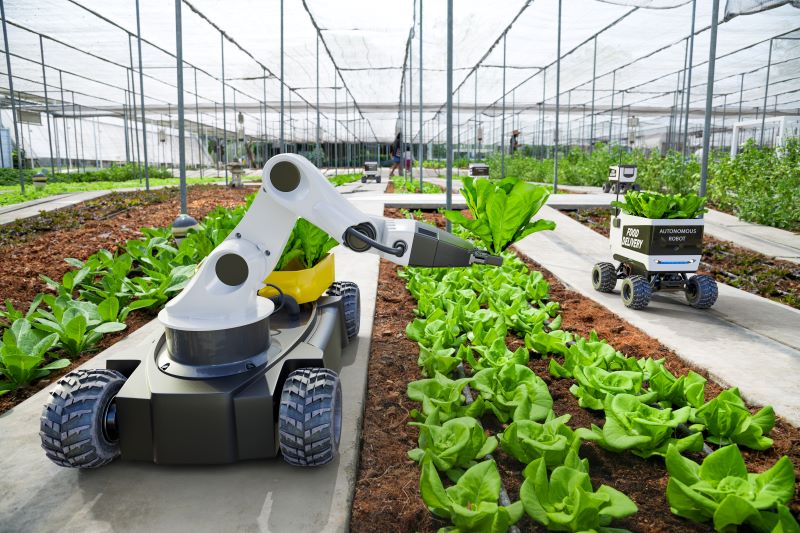Agricultural technology has changed drastically since humans began cultivating plants for food. In fact, our modern system would be unrecognizable to our early farming ancestors. And these technological advances show no signs of slowing down; in many ways, they’re speeding up!
Although no one knows exactly what the future will bring, we can look at what technologies are already being developed to identify future trends. Staying aware of innovations in farming as well as other tech fields like manufacturing, SaaS, and HardTech, makes predicting and developing the future of agriculture easier. That’s why attending an Ag Tech conference that involves cross-sector collaboration can be so powerful. Rally is the largest cross-sector global innovation conference that brings together these industries to help create the future of agriculture technology.
What Is the Future of the Agriculture Industry?
Modern agriculture has already begun the next revolution, often called Agriculture 4.0: The Future of Farming Technology. The big distinguishers for this new agricultural revolution include a focus on:
- Precision agriculture
- Use of the internet of things (IoT)
- Collecting and applying big data
- AI and machine learning
It is very likely that the future of farming in America and across the globe will continue to build on the early prototypes being developed in these areas.
How Will Farming Change in the Next 20 to 30 Years?
Some farms are already implementing new technologies that are revolutionizing the way they operate. In the next 20-30 years, we will almost certainly see the wider spread adoption of these early programs to become industry standard. This includes advances like:
- Precision sensors to monitor light, water, and nutrient needs that vary from plant to plant.
- Automated distributors of water and fertilizer, like drones and precision irrigation.
- Supply chain improvements, like blockchain to better monitor food origin and safety.
- Smart equipment like weeding machines, drones that can identify individual diseased plants in a field.
- Analytics coming from big data that improve our knowledge about how much and what type of amendments are needed for crop and animal health.
What Is the Biggest Challenge with the Future of Agriculture?
Agriculture is an incredibly complex system that must balance the moving pieces of society, climate change, plants, animals, diseases, and economics. It’s impossible to accurately predict what the challenges of agriculture in the future will be. Our current understanding of future challenges includes those associated with:
- Climate Change | Changes in our climate have already had large effects on agriculture. The best species of crops and animals to rely on in different parts of the world have changed as the climate has. Pest and disease pressures, less predictable weather patterns, and changing water availability are all challenges future agriculture will continue to face.
- Loss of Biodiversity | Farming practices of the past have resulted in a dramatic drop in the number of different plant and animal species in the world. 87% of food production relies on animal pollinators, and biodiversity in plant species is necessary for pest and disease resistance as well as healthy ecosystems.
- Changing Consumer Tastes | What consumers want from their food changes over time. Agriculture needs to adapt to these changes so farmers are growing not just enough food, but food that meets the needs and expectations of the market.
- Ethics of Food Production | Regulating bodies, consumers, and the agriculture industry as a whole have become more aware of and concerned about the ethics of raising food to feed our world. The future of agriculture will need to continue to improve the environmental impact of farming, as well as the impact on farm workers and rural communities.
Which Farming Is the Best for the Future?
The more we learn and improve the way we produce food, the more obvious it becomes that the future of farming technology will focus on environmental sustainability and improving the resilience of our food systems. Technologies that are allowing us to grow more food with less damage to the earth are already being developed and used, and these trends will continue to be the best options in the future.
Why Is Cross-Sector Collaboration Important for the Future of Farming?
In order to meet the challenges that agriculture faces, and see current innovations become mainstream, agriculture needs to be a part of cross-collaboration initiatives. Staying siloed in one field means an industry misses out on important innovations happening in other areas. In a field as important as agriculture, staying up-to-date on what technologies are out there is hugely important.
That’s why Rally set out to become the largest global cross-sector innovation conference. We have created a world-class event that allows thought leaders from six major industries to share what they are doing and be inspired by others. These six industries are:
- Ag & Food
- Entrepreneurship
- HardTech
- SportsTech
- Healthcare
- Software
Get in on the cutting edge of technological advances so you can help shape the future of agriculture. Learn more about our program, including how to participate in the demo arena, or meet one-on-one with venture firms looking to invest in your idea!
